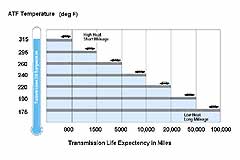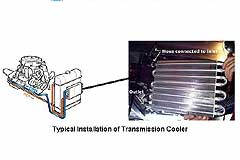You've seen it all too often, a car, SUV or light truck on the side of the road, hood up, while the engine as cools down. More than likely, the vehicle is on a steep hill and pulling some type of trailer. Even though the vehicle can be driven off after things cool down, there is a good chance the transmission could have suffered serious and expensive damage that could have been prevented by installing an auxiliary transmission cooler.

According to the Automatic Transmission Rebuilders Association, overheating causes nine out of ten transmission failures.
Under normal driving conditions, Automatic Transmission Fluid (ATF) will be at about 170-175 degrees F, and it could go for 100,000 miles, or more, without problems.
At higher temperatures ATF oxidizes, turns brown, and takes on a burnt smell. Excessive heat destroys the ATF's lubricating and friction characteristics. Also varnish forms on internal parts interfering with the operation of the transmission. If the temperature gets above 250 degrees F., rubber seals begin to harden, which leads to leaks. At higher temperatures the transmission begins to slip further aggravating overheating. Eventually the clutch burns out and you have an expensive overhaul. As a rule of thumb, for every 20 degrees F increase in operating temperature, above the design temperature, transmission life is cut in half.
As ATF circulates through the transmission and torque converter it absorbs heat. It gives up this heat when it passes through the factory-installed equipment transmission cooler, a small heat exchanger integrated inside the bottom or end tank of the radiator.
While the stock transmission cooler may be adequate for normal driving, additional cooling is needed when pulling a trailer, carrying a heavy load, climbing hills, traveling in hot weather, and so forth. With vehicle radiator temperatures normal ly at 180 to 220 degrees F, ATF cooling is marginal. For instance, if ATF enters the radiator cooler at 300 degrees F under severe conditions it may leave at 240 to 270 degrees F., which is not anywhere sufficient for extended fluid life.
Therefore, an auxiliary transmission oil cooler, a separate radiator that generally mounts in front of the regular radiator is needed. While a cooler is pretty much a must for trailer towing, they are a good investment if you live in a hot climate, or pull a heavy load like a large family, or a carpool with many passengers.

Tubing carries hot ATF to this radiator, while return lines deliver cooler fluid back to the transmission. The best way to obtain an auxiliary cooler is to order a vehicle with an auxiliary cooler already installed. For instance, most towing packages includes one. If not, an auxiliary transmission fluid cooler is relatively easy to install on most vehicles.
Incidentally, trailer rental companies like U-Haul sell transmission cooler since their trailers are very like to be pulled by vehicles with maginal cooling capability.
If possible, purchase a cooler made for your particular vehicle rather than a universal one. This makes for easier installation and assures the cooler is up to the task. The best location for the auxiliary cooler is in front of the radiator, but any place with good airflow will work. In cases where there is no space for a transmission cooler, ones with electric fans attached are available. These can be mounted just about anywhere.
Installing an auxiliary cooler can be done by most competent do-it-yourselfers. It does not usually require any special tools, and all the hardware needed should come with the cooler, though in some cases you might have to adapt some fittings for your particular vehicle. Be sure the lines are not hanging down or rubbing against something.
Once completely installed, start the engine and allow pressure to build up. Check for leaks at every point in the system. If there are leaks, shut off the engine and fix them. Then road test the vehicle so the ATF heats up to operating temperature and check again for leaks, and repair if necessary.
Installing a transmission cooler is a good time to replace transmission fluid and filters as well. Also consider switching to a synthetic transmission fluid which gives an extra bit of cooling capability. While synthetic ATFs are more expensive than a mineral oil based ATFs, it is still a lot cheaper than a transmission rebuild.




